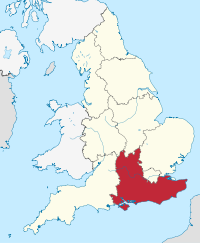South east England
| South East England | |
|---|---|

South East England region in England
|
|
| Sovereign state | United Kingdom |
| Country | England |
| Status | Region |
| Government | |
| • Leaders' board | South East England Councils |
| • EP constituency | South East England |
| Area | |
| • Total | 7,373 sq mi (19,095 km2) |
| Area rank | 3rd |
| Population (2011) | |
| • Total | 8,635,000 |
| • Rank | 1st |
| • Density | 1,200/sq mi (450/km2) |
| GVA | |
| • Total | £227 billion |
| • Per capita | £22,624 (2nd) |
| NUTS code | UKJ |
| ONS code | E12000008 |
| Website | www |
South East England is the most populous of the nine official regions of England at the first level of NUTS for statistical purposes. It consists of Berkshire, Buckinghamshire, East Sussex, Hampshire, the Isle of Wight, Kent, Oxfordshire, Surrey and West Sussex. As with the other regions of England, apart from Greater London, the south east has no elected government.
It is the third largest region of England, with an area of 19,096 km² (7,373 sq mi), and is also the most populous with a total population of over eight and a half million (2011). The headquarters for the region's governmental bodies are in Guildford, and the region contains seven cities: Brighton and Hove, Canterbury, Chichester, Oxford, Portsmouth, Southampton and Winchester, though other major settlements include Reading and Milton Keynes. Its proximity to London and connections to several national motorways have led to south east England becoming an economic hub, with the largest economy in the country outside the capital. It is the location of Gatwick Airport, the UK's second-busiest airport, and its coastline along the English Channel provides numerous ferry crossings to mainland Europe.
...
Wikipedia
